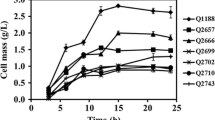Abstract
Klebsiella pneumoniae produces many economically important chemicals. Using glucose as a carbon source, the main metabolic product in K. pneumoniae is 2,3-butanediol. Gluconic acid is an intermediate of the glucose oxidation pathway. In the current study, a metabolic engineering strategy was used to develop a gluconic acid-producing K. pneumoniae strain. Deletion of gad, resulting in loss of gluconate dehydrogenase activity, led to the accumulation of gluconic acid in the culture broth. Gluconic acid accumulation by K. pneumoniae Δgad was an acid-dependent aerobic process, with accumulation observed at pH 5.5 or lower, and at higher levels of oxygen supplementation. Under all other conditions tested, 2,3-butanediol was the main metabolic product of the process. In fed batch fermentation, a final concentration of 422 g/L gluconic acid was produced by K. pneumoniae Δgad, and the conversion ratio of glucose to gluconic acid reached 1 g/g. The K. pneumoniae Δgad described in this study is the first genetically modified strain used for gluconic acid production, and this optimized method for gluconic acid production may have important industrial applications.
Graphical Abstract
Gluconic acid is an intermediate of this glucose oxidation pathway. Deletion of gad, resulting in loss of gluconate dehydrogenase activity, led to the accumulation of gluconic acid in the culture broth. In fed batch fermentation, a final concentration of 422 g/L gluconic acid was produced by the K. pneumoniae Δgad strain, and the conversion ratio of glucose to gluconic acid reached 1 g/g.






Similar content being viewed by others
References
An D, Ye A, Deng W, Zhang Q, Wang Y (2012) Selective conversion of cellobiose and cellulose into gluconic acid in water in the presence of oxygen, catalyzed by polyoxometalate-supported gold nanoparticles. Chem Eur J 18:2938–2947
Anastassiadis S, Rehm H-J (2006) Continuous gluconic acid production by Aureobasidium pullulans with and without biomass retention. Electron J Biotechnol 9:494–504
Attwood MM, van Dijken JP, Pronk JT (1991) Glucose metabolism and gluconic acid production by Acetobacter diazotrophicus. J Ferment Bioeng 72:101–105
Baneyx F, Ayling A, Palumbo T, Thomas D, Georgiou G (1991) Optimization of growth conditions for the production of proteolytically-sensitive proteins in the periplasmic space of Escherichia coli. Appl Microbiol Biotechnol 36:14–20
Bin DS, Wang H, Li JX et al (2014) Controllable oxidation of glucose to gluconic acid and glucaric acid using an electrocatalytic reactor. Electrochim Acta 130:170–178
Bouvet OMM, Lenormand P, Grimont PAD (1989) Taxonomic diversity of the d-glucose oxidation pathway in the Enterobacteriaceae. Int J Syst Bacteriol 39:61–67
Chen C, Wei D, Shi J, Wang M, Hao J (2014) Mechanism of 2, 3-butanediol stereoisomer formation in Klebsiella pneumoniae. Appl Microbiol Biotechnol 98:4603–4613
Crognale S, Petruccioli M, Fenice M, Federici F (2008) Fed-batch gluconic acid production from Penicillium variabile P16 under different feeding strategies. Enzyme Microb Technol 42:445–449
Gust B, Challis GL, Fowler K, Kieser T, Chater KF (2003) PCR-targeted Streptomyces gene replacement identifies a protein domain needed for biosynthesis of the sesquiterpene soil odor geosmin. Proc Natl Acad Sci 100:1541–1546
Hao J, Lin R, Zheng Z, Liu H, Liu D (2008) Isolation and characterization of microorganisms able to produce 1,3-propanediol under aerobic conditions. World J Microbiol Biotechnol 24:1731–1740
Kumar C, Yadav K, Archana G, Kumar GN (2013) 2-Ketogluconic acid secretion by incorporation of Pseudomonas putida KT 2440 gluconate dehydrogenase (gad) operon in Enterobacter asburiae PSI3 improves mineral phosphate solubilization. Curr Microbiol 67:388–394
Neijssel O, Tempest D (1975) Production of gluconic acid and 2-ketogluconic acid by Klebsiella aerogenes NCTC 418. Arch Microbiol 105:183–185
Ramachandran S, Fontanille P, Pandey A, Larroche C (2006) Gluconic acid: properties, applications and microbial production. Food Technol Biotechnol 44:185–195
Ramos ML, Caldeira MM, Gil VM (1997) NMR spectroscopy study of the complexation of d-gluconic acid with tungsten (VI) and molybdenum (VI). Carbohydr Res 304:97–109
Rinsant D, Chatel G, Jerome F (2014) Efficient and selective oxidation of d-glucose into gluconic acid under low-frequency ultrasonic irradiation. ChemCatChem 6:3355–3359
Sankpal N, Kulkarni B (2002) Optimization of fermentation conditions for gluconic acid production using Aspergillus niger immobilized on cellulose microfibrils. Process Biochem 37:1343–1350
Seiskari P, Linko Y-Y, Linko P (1985) Continuous production of gluconic acid by immobilized Gluconobacter oxydans cell bioreactor. Appl Microbiol Biotechnol 21:356–360
Sharma N, Parshad R, Qazi G (1992) Electron transport system associated with direct glucose oxidation in Gluconobacter oxydans. Biotechnol Lett 14:391–396
Singh OV, Kumar R (2007) Biotechnological production of gluconic acid: future implications. Appl Microbiol Biotechnol 75:713–722
Sun YH, Shi JP, Han ZS (2014) Two-stage fermentation for 2-ketogluconic acid production by Klebsiella pneumoniae. J Microbiol Biotechnol 24:781–787
Tlemçani LL, Corroler D, Barillier D, Mosrati R (2008) Physiological states and energetic adaptation during growth of Pseudomonas putida mt-2 on glucose. Arch Microbiol 190:141–150
Tomotani EJ, Vitolo M (2007) Immobilized glucose oxidase as a catalyst to the conversion of glucose into gluconic acid using a membrane reactor. Enzyme Microb Technol 40:1020–1025
Wang D, Zhou J, Chen C et al (2015) R-acetoin accumulation and dissimilation in Klebsiella pneumoniae. J Ind Microbiol Biotechnol 42:1105–1115
Wei D, Wang M, Shi J, Hao J (2012) Red recombinase assisted gene replacement in Klebsiella pneumoniae. J Ind Microbiol Biotechnol 39:1219–1226
Wei D, Xu J, Sun J, Shi J, Hao J (2013) 2-Ketogluconic acid production by Klebsiella pneumoniae CGMCC 1.6366. J Ind Microbiol Biotechnol 40:561–570
Wei D, Wang M, Jiang B, Shi J, Hao J (2014) Role of dihydroxyacetone kinases I and II in the dha regulon of Klebsiella pneumoniae. J Biotechnol 177:13–19
Acknowledgments
This work was supported by a Grant from the KRIBB Research Initiative Program (KGM2211531) and National Natural Science Foundation of China (Grant Nos. 20906076, 21576279).
Author information
Authors and Affiliations
Corresponding authors
Rights and permissions
About this article
Cite this article
Wang, D., Wang, C., Wei, D. et al. Gluconic acid production by gad mutant of Klebsiella pneumoniae . World J Microbiol Biotechnol 32, 132 (2016). https://doi.org/10.1007/s11274-016-2080-x
Received:
Accepted:
Published:
DOI: https://doi.org/10.1007/s11274-016-2080-x




